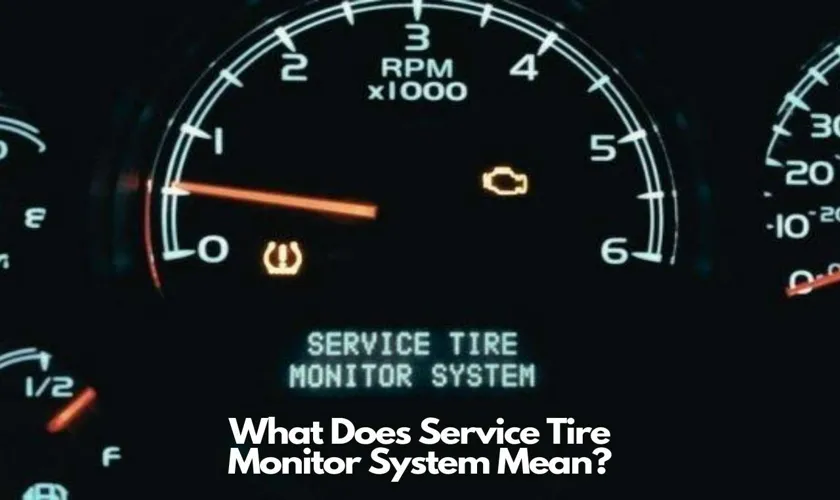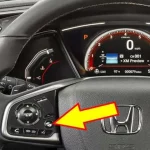Have you ever wondered why your car dashboard sometimes flashes a warning light indicating low tire pressure? It’s all thanks to the Tire Pressure Monitoring System (TPMS). This system is designed to alert drivers when one or more tires on their vehicle are underinflated and may be causing safety risks. TPMS uses sensors to monitor the air pressure inside each tire and can accurately detect when the pressure drops below the manufacturer’s recommended guidelines.
Without this technology, low tire pressure could cause damage to the tires, impair steering, or compromise vehicle stability. So, let’s dive deeper and explore the features, benefits, and downsides of the TPMS technology.
Table of Contents
Understanding the TPMS
Have you ever seen that “service tire monitoring system” warning appear on your dashboard? This likely means that there is an issue with your TPMS, or tire pressure monitoring system. TPMS is a safety feature that ensures your tires are properly inflated, which not only improves handling and fuel efficiency but also prevents blowouts caused by underinflated tires. When the TPMS senses an abnormal change in tire pressure, it will trigger a warning on the dashboard.
It’s important not to ignore this warning, as it could signal a serious problem. The most common causes of a TPMS issue are low tire pressure, a dead sensor battery, or a malfunctioning sensor. If you’re unsure about how to address the problem, it’s best to take your vehicle to a trusted mechanic who can diagnose and fix the problem for you.
How TPMS works
TPMS, or Tire Pressure Monitoring System, is a technology that monitors the air pressure in your vehicle’s tires. Essentially, it keeps you informed if the pressure is too low or too high, which ultimately affects your safety while driving. The TPMS sensors are located in each tire, and they send a signal to your vehicle’s computer to display the tire pressure readings.
There are two types of TPMS systems: indirect and direct. Indirect TPMS systems utilize the wheel speed sensors to measure the rotation of each tire. On the other hand, direct TPMS systems use pressure sensors located in each tire to provide an accurate reading of the tire pressure.
Direct TPMS systems are considered more accurate and reliable, although they are also more expensive. It is important to understand how the TPMS works so that you can ensure the proper maintenance of your tires and be aware of any potential safety issues while driving.

TPMS components
The TPMS (Tire Pressure Monitoring System) is a vital component in modern vehicles that ensures the optimal performance of the tires. The system has two types – direct and indirect. Direct TPMS uses sensors mounted inside each tire to monitor the air pressure and temperature in real-time.
On the other hand, Indirect TPMS uses the ABS (anti-lock braking system) wheel speed sensors to detect the irregularity in tire rotation caused by low air pressure. The control module receives data from these sensors and alerts the driver through visual or audible warning signals when the tire pressure drops below the recommended level. The TPMS components include tire pressure sensors, a control module, and a warning light display.
Each component plays a crucial role in maintaining the accuracy and efficiency of the TPMS. Proper understanding of the TPMS components is essential to ensure the safety of the driver and passenger, as well as in conserving fuel savings and prolonging the life of the tire.
Causes of Service Tire Monitoring System Warning
If you’ve ever seen the “Service Tire Monitoring System” warning on your dashboard, you may be wondering what it means. This warning is typically triggered by an issue with the tire pressure monitoring system (TPMS). The TPMS works by using sensors in your tires to measure tire pressure and temperature, which is then relayed to your vehicle’s computer system.
If the system detects any irregularities, such as a low tire pressure or a malfunctioning sensor, it will trigger the warning light. Some common causes of TPMS issues include low tire pressure, damaged sensors, dead batteries in the sensors, or a malfunctioning TPMS control module. While it may be tempting to ignore the warning, it’s important to have your TPMS system checked and repaired by a professional mechanic to ensure your safety on the road.
Low tire pressure
When it comes to the Service Tire Monitoring System Warning, one of the most common causes is low tire pressure. This warning could indicate that one or more of your tires have lower than the recommended pressure range, which can lead to reduced fuel efficiency, increased tire wear, and even blowouts in extreme cases. Low tire pressure can be caused by a puncture, damaged valve, or slow leaks over time.
It is essential to regularly check your tire pressure and ensure that they are inflated to the manufacturer’s recommended pressure levels. By doing this, you will not only avoid the Service Tire Monitoring System Warning but also ensure safety and prolong the life of your tires. So, be sure to keep an eye on your tire pressure regularly and avoid this common service warning!
Damaged TPMS sensor
One of the most common causes of a Service Tire Monitoring System (TPMS) warning is a damaged TPMS sensor. This essential component of your vehicle’s tire pressure monitoring system can become damaged due to a variety of reasons, including road hazards, corrosion, or even a dead battery. When the sensor is damaged, it can no longer accurately measure the tire pressure and will trigger a warning light on your dashboard.
It’s important to have the sensor replaced as soon as possible to avoid any potential safety hazards on the road. Additionally, keep in mind that regular maintenance such as checking tire pressure and replacing the sensors as needed can help prevent this issue from occurring in the first place. By staying on top of your vehicle’s TPMS system, you can ensure a smooth and safe ride every time you hit the road.
TPMS control module malfunction
The service tire monitoring system (TPMS) warning light can be a cause for concern for many drivers. One common issue that triggers this warning is a malfunctioning TPMS control module. The TPMS control module is responsible for collecting information from the tire pressure sensors and communicating that information to the vehicle’s computer.
When the control module malfunctions, it can cause inaccurate readings or fail to communicate with the vehicle’s computer altogether. There are several reasons why the TPMS control module may malfunction, including electrical faults, moisture intrusion, or damage caused by impact or corrosion. Regular tire maintenance and monitoring the TPMS system can help prevent this warning from appearing and ensure proper tire pressure and vehicle safety.
What to do when you see Service Tire Monitoring System warning
If you see a message on your dashboard that reads “Service Tire Monitoring System,” it means that there is something wrong with your car’s tire pressure monitoring system. This system is designed to warn you if your tires are underinflated, which can cause a variety of issues such as reduced fuel efficiency, poor handling, and even tire failure. If you see this message, you should immediately check your tire pressure to make sure that all of your tires are properly inflated.
If your tires are properly inflated and the message persists, it is best to take your car into a mechanic to have it serviced. Remember, properly inflated tires are crucial to your safety on the road, so don’t ignore this important warning message.
Check tire pressure
If your car’s Service Tire Monitoring System warning light comes on, the first thing you’ll want to do is check your tire pressure. Low tire pressure can cause excessive wear and tear on your tires, leading to decreased fuel efficiency and even a blowout. To check your tire pressure, use a tire gauge to measure the pressure in each tire.
If the pressure is low, fill your tires to the recommended pressure listed in your car’s owner’s manual. It is important to note that tire pressure can fluctuate with changes in temperature, so it’s important to check your tire pressure regularly to ensure your tires are properly inflated. By staying on top of your tire pressure, you can prevent costly tire damage and keep your car running smoothly on the road.
Check for tire damage
If you see the service tire monitoring system warning light on your dashboard, it’s important not to ignore it. This warning usually means that there is an issue with one or more of your tires, and it’s critical to address it as soon as possible. One common reason for this warning light is tire damage, which can occur due to a variety of reasons, including punctures, tread wear and tear, or even hitting a pothole.
The first step is to check the tire visually for any obvious signs of damage, such as cuts, bulges, or cracks. If you spot any damage, you should have the tire repaired or replaced as soon as possible to avoid further damage and potential safety risks on the road. Remember, even a small issue with your tire can lead to a blowout, which can be very dangerous, so it’s always better to err on the side of caution when it comes to your tires.
Diagnose the issue with a professional
If you see the Service Tire Monitoring System warning light on your vehicle, don’t ignore it! It means that there’s a problem with your tire pressure monitoring system (TPMS), and you should take action right away to diagnose the issue. The TPMS is an important safety feature that helps you avoid accidents caused by underinflated tires. The warning light may be caused by a malfunctioning sensor, a dead battery in the sensor, or a problem with the TPMS module.
The best course of action is to take your vehicle to a professional mechanic as soon as possible to have it diagnosed. They will use specialized tools to check the system and determine the root cause of the issue. Ignoring warning lights can lead to expensive repairs and even dangerous situations on the road.
Don’t wait until it’s too late, take your vehicle in for a check-up and ensure your safety on the road.
Benefits of TPMS
If you see a message that says “service tire monitoring system,” it means there’s something wrong with your TPMS. TPMS or Tire Pressure Monitoring System is designed to alert drivers when their tire pressure is below the recommended level, which can increase the risk of accidents. If your TPMS light comes on, it’s essential to address the issue as soon as possible to ensure your safety on the road.
In addition to avoiding potential accidents, TPMS also offers several other benefits. For instance, it helps improve fuel efficiency by ensuring your tires are inflated to the correct level, which reduces resistance and rolling friction. Moreover, TPMS alerts drivers when there’s a leak or puncture in the tire, enabling timely repairs and preventing costly replacements.
Overall, if you see the ‘service tire monitoring system’ message, take your vehicle to a qualified mechanic immediately and ensure your tires are in good condition.
Improved safety
One of the greatest benefits of having a Tire Pressure Monitoring System (TPMS) in your vehicle is improved safety. A TPMS can alert you when your tire pressure is dangerously low, which reduces the chances of a blowout or a flat tire while driving. This is especially important when you consider the fact that many drivers don’t check their tire pressure regularly.
Low pressure in your tires not only increases the risk of a blowout, but also affects the handling of your vehicle and can lead to decreased fuel efficiency. With a TPMS, you’ll have a constant reminder to ensure your tires are properly inflated, which leads to better overall vehicle performance and increased safety on the road. So, if you’re looking for an easy way to improve your driving safety, consider adding a TPMS to your vehicle today.
Better fuel efficiency
If you’re looking to improve your vehicle’s fuel efficiency, investing in a TPMS, or Tire Pressure Monitoring System, can be incredibly beneficial. This system works by alerting you when your tire pressure is low, which helps prevent wear and tear on your tires and reduces the amount of resistance your vehicle experiences while driving. By maintaining proper tire pressure, you can improve your car’s gas mileage and achieve better fuel efficiency overall.
Plus, with a TPMS, you’ll be able to stay on top of tire maintenance more easily, preventing unexpected blowouts or other tire-related issues. In the end, the investment in a TPMS can save you money in the long run and make your driving experience more comfortable and efficient.
Conclusion
In summary, the message “service tire monitoring system” is simply your car’s way of politely reminding you to mind your Ps and Qs with regards to maintaining your tires. Just like how your mother would remind you to brush your teeth to avoid cavities, your car is reminding you to keep an eye on your tire’s air pressure and wear to avoid any unexpected blowouts or punctures. So, the next time you see that message light up on your dashboard, take it as a friendly warning from your trusty steed and give your tires the TLC they deserve!”
Importance of TPMS for proper tire maintenance
TPMS or Tire Pressure Monitoring System If you’re looking for a way to keep your vehicle’s tires in great condition, investing in a TPMS is a perfect place to start. TPMS, or tire pressure monitoring system, is an important tool that alerts you when your tire pressure is low, allowing you to take action before any damage is done to your vehicle or tires. There are several benefits of having a TPMS on your vehicle.
First, it helps increase fuel efficiency by keeping your tires properly inflated, which can save you money in the long run. Additionally, it increases your vehicle’s stability and handling, making it safer to drive. Finally, it can help extend the life of your tires and reduce the need for costly repairs.
With a TPMS, you can easily monitor your tire pressure and ensure that your vehicle is performing at its best while also staying safe on the road. So, if you haven’t invested in a TPMS yet, it’s definitely worth considering to improve your tire maintenance today.
FAQs
What is the tire monitoring system?
The tire monitoring system is an electronic system that monitors the air pressure and temperature of the tires.
What does “service tire monitoring system” warning mean?
The warning “service tire monitoring system” means there is a problem with the tire monitoring system, and it needs to be checked.
What should I do when the “service tire monitoring system” warning appears?
You should take your vehicle to a mechanic to have the system checked and repaired.
Can I drive my car when the “service tire monitoring system” warning appears?
It is recommended not to drive your car when the “service tire monitoring system” warning appears because it can cause a safety issue.
How do I reset the tire monitoring system after servicing?
You can reset the tire monitoring system by following the instructions in the owner’s manual or taking it to a mechanic for resetting.
How often does the tire monitoring system need to be serviced?
The tire monitoring system does not require regular maintenance. However, if the warning appears, it should be serviced immediately.
Is the “service tire monitoring system” warning only related to tire pressure?
No, the “service tire monitoring system” warning can also appear if there is a problem with the sensors or wiring of the tire monitoring system.



